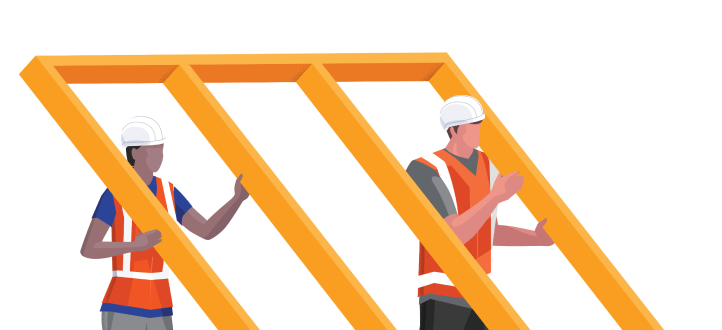— 12 min read
Construction Insolvency: Preventive Strategies for Contractors & Builders
Last Updated Dec 18, 2023

Construction is one of the most vulnerable industries for insolvency, and that’s during a typical economic climate. When you pile on challenges with supply chains and labour availability -- in addition to rapidly increasing costs -- you can see why more Australian construction companies are going belly up every day.
So, what will you do to stop the runaway train? In this article, we’ll focus on the issue of construction insolvency in Australia and provide insights, tips, and strategies for builders and contractors to prevent insolvency risks.
Table of contents
Insolvency Explained
According to the Australian Securities & Investments Commission (ASIC), insolvency is "when a company or person can't pay their debts once they come due."
That paints a pretty clear picture: If a construction company can't pay their debts, they are insolvent. Of course, an inability to pay existing debts doesn’t necessarily mean the company will go out of business. However, it warrants further scrutiny and close investigation.
Procedures
In the case of corporate insolvency, the most common procedures are liquidation, voluntary administration, and receivership.
Liquidation
Liquidation is the technical term for selling off a company’s assets.
Actual cash and bank accounts are the most liquid, followed by stock accounts, accounts receivable, etc. You can’t use cranes, diggers, and power tools to barter, so you have to sell them first if you want to use them to pay off debts.
The idea of liquidation in the context of insolvency is that you’re selling off business assets to repay your outstanding debts.
This process can be voluntary, such as in the case of a Creditors Voluntary Liquidation (CVL), where company shareholders agree that the business is insolvent and its assets must be sold off.
However, liquidation can also be court-ordered should a company’s creditors (the people and businesses to whom it owes money) decide to pursue legal action against the organisation.
Administration
Administration is when a third party enters to get your construction company out of a financial mess.
This is voluntary but can also be court-ordered on behalf of creditors.
The idea with administration is that there is the possibility that the administrator can turn things around and keep the company alive.
For instance, they might scale down, sell off some contracts, liquidate assets, and get the business to a leaner operating level. More commonly, though, this process simply results in liquidation.
Receivership
Receivership is when one or more of your creditors (via a dedicated party known as the receiver) take control of your company’s assets and sell them off to reclaim the cash owed. The court generally appoints receivership.
Understanding what key terms mean and how to use them is an important first step, and will help you get a better handle on the current state of construction insolvency.
Why Construction Companies Are Vulnerable to Insolvency
Construction companies are particularly vulnerable to becoming insolvent for several reasons.
- Payments in arrears can create negative cash flow.
Construction contracts typically allow payments in arrears, which creates cash flow issues for contractors and builders. Contractors need to fork out for labour and materials well before they can recoup the expenses. Any delay in payment can cause a shortfall in cash flow, leaving a company unable to service its debt.
- Fixed-price contracts leave contractors vulnerable to price fluctuations.
Fixed-price contracts are the norm in construction, which is problematic when costs are unstable. You might agree to a job now that doesn’t wind up for another 18 months. During that time, labour and materials costs can change significantly, which can easily leave you out of pocket on that project.
- Financial problems can trickle down on a construction project.
Construction projects typically involve a long chain of suppliers and subcontractors, all likely working on fixed-price, payment-in-arrears projects. If a company at the top of the chain goes under financially, this can create a huge ripple effect for every other contractor and business relying on payment.
All of this takes place even during economic growth, but things get worse when the economy is shrinking or trying to recover from a collapse. That’s because there is a delay between buyer confidence increasing and new construction projects starting.
Choosing to build a new project (whether a home, apartment building, or mall) is different from the decision to buy a new fridge. The planning stage is much longer, leaving a large gap between the economic recovery and the construction industry prospering.
The Rise in Construction Insolvency
If you're operating in Australia, you're no stranger to the challenges we face post-COVID.
“This slowdown is going to catch them out, and that’s the reason why we will see a lot more liquidations over the next six months – it’s going to get worse before it gets better," Russ Stephens, co-founder of the Association of Professional Builders told MPA. "The sales process can take up to six to 12 months for builders. We are seeing consumers in that process have second thoughts and sit back and wait and see what happens with builders, interest rates and inflation. We are also seeing the amount of new inquiries start to slow down as well. It’s nothing too dramatic when compared to pre-COVID, but in the context of how busy it was during the COVID boom it’s a considerable slowdown on demand.”
The building slowdown Stephens referenced has already taken its toll.
Millbrook Homes went into administration in June of 2023 with more than $4 million in debt. Just four days later, Bentley Homes appointed liquidators.
And these are just two examples. MPA notes that construction insolvencies have increased by 65% yearly, far outpacing the overall insolvency growth of 10%.
ASIC’s insolvency statistics bear out the same news: Of all industries, construction tops the list for the number of companies entering external administration.
Behind these devastating numbers lie three core challenges:
- Supply chain issue
- Inflation and material price increase
- Labour shortages
Supply Chain Issues
Global supply chain issues started at the beginning of the pandemic, with timber becoming difficult to access worldwide.
This was compounded in Australia by introducing programs designed to boost the initiation of new construction during the same time.
Add to that the fact that Russia is a major global timber producer, where a large chunk of our timber comes from, and the federal government’s 35% import tariff on “conflict timber” from Russia and Belarus, and materials are not only hard to access, but a whole lot more expensive.
Inflation and Price Increases
ABC notes that the price of raw materials (timber and steel) increased by 50% during the pandemic due to supply chain issues and inflation. This becomes a massive problem for those projects that were agreed pre-pandemic and are still underway, where such significant price increases have destroyed existing profit margins.
As Brett Boulton, director of Bold Living, put it, “What we’re finding is there’s a very large difference in terms of what their price is and what their price should be.”
Labour Shortages
Even if projects could move forward and produce reasonable profits, it takes time to find qualified, skilled workers in Australia right now.
The problem? Nobody seems to want to work in construction.
In 1989, we had about 160,000 trade apprentices in training across Australia. Thirty years later, that number grew by just 13%, while the country's total population grew by 50%.
If Econ 101 has taught us anything, it's that when supply is low, and demand is high, the price increases, making labour more expensive.
Unfortunately, it's probably going to get worse.
Timothy Hibbert, head of construction and property forecasting at Oxford Economics, forecasts a 21% drop in building activity over the next three years:
“New home sales, dwelling approvals and home construction loans have deteriorated, setting the scene for a deep residential downturn.”
That's disheartening news—but it doesn't mean your construction company won't see the light at the end of the tunnel.
If you’re determined to be one of them, you’ll want to know how to spot the common signs of construction insolvency so you pull the breaks on the train early.
These challenges seem daunting, but remember, with this foreknowledge comes the ability to adapt and succeed. In the next chapter, we’ll show you how.
Common Signs of Insolvency in Construction
Here are the five most common signs of pending insolvency in construction companies.
Consider this a quick financial checklist. If you spot one or more of these signs, it might be a cause for concern unless there is a good reason (like you're re-negotiating payment terms as part of a new procurement management program).
Cash Flow Issues
Cash flow issues are often the first sign of a bad financial situation.
If you're not getting money into your business as quickly as you'd like, usually because customers are late with their payments or you're regularly spending more than you're earning, it could be a sign that your finances are in trouble. It’s especially concerning if you need to invest that money back into your business.
Late Payment of Invoices
Paying supplier invoices late is typically a consequence of issues with cash flowing into the business.
This could also mean your work needs to make more money, especially if your costs have recently increased.
A company in good financial health should be able to pay its invoices on time. If you’re struggling, this may be an early warning sign.
Renegotiation of Payment Terms
Regular renegotiation of payment terms to suppliers can also be a red flag.
It's one thing if you’re overhauling your vendor management framework and renegotiating contracts and payment agreements as part of the process.
But if that renegotiation is happening regularly, on an invoice-by-invoice basis, and driven by the fact that your business can’t pay on time—it might be a bad sign.
Unexpected Changes to Projects or Staffing
Unexpected changes to projects or workforce planning, specifically when driven by the need to cut costs, should also be noted as a potential cause for concern when it comes to the threat of construction insolvency.
Late Filing of Annual Returns
Lastly, if your construction business regularly files annual returns with the ATO, this may be a sign that your overall financial management could be better.
A healthy organisation should be able to create and file returns without delay and easily provide all financial records to their accounting partner.
5 Strategies to Protect Against Insolvency
Are you worried that your construction company might be facing financial troubles? Or do you want to be proactive and guard against future downturns?
Here are five practical tips to help you reduce the risk of going broke, even in a challenging economy.
1. Improve cash flow management practices.
If you can get your cash flow sorted, you’ll have little issue paying suppliers, preventing the risk of creditors taking action against you.
Here are a few ways to improve cash flow management:
- Rent equipment instead of purchasing it (so you’re not paying for anything during downturns)
- Enforce firm supplier payment boundaries and collect interest or fees on late payments
- Centralise budget and spending data in a construction project financial platform
2. Leverage financial and project management technology.
A solid construction-focused project management platform can help you create project budgets, manage cash flowing in and out of the business, and provide better cost estimates.
For instance, estimating software can use historical rate tables to help you create more accurate job cost estimates, increasing your ability to run profitable projects.
Workforce planning and scheduling are equally important. Maximising your effective use of human resources can offset some of the impacts of increasing materials costs by reducing total labour spending.
3. Focus on relationship management.
Your company doesn’t exist in a vacuum. You work with other suppliers and businesses, and a big part of construction insolvency risk is the potential for another party involved in your projects to go bust.
Mitigate against the risk by:
- Creating and enforcing a due diligence checklist on all suppliers and subcontractors
- Maintaining close contact and regular check-ins with key partners
- Advocating for transparency in communication around financial risk
4. Diversify service offerings.
Coming up with new ways to make money is important if you want your business to survive during hard times.
Consider other options to drive income, even if they are a temporary stopgap.
For example, if you’re experiencing a downturn and don’t have a lot of work for a few months, can you sub-contract some of your permanent labour to another company with whom you have a healthy working relationship?
5. Keep up-to-date with industry trends and regulations.
Lastly, pay attention to what’s going on in your industry.
Stay up to date with issues related to supply chains, materials, and labour laws. Keep an eye on how other construction companies are faring financially, especially if they’re involved in your projects.
The domino effect can be a construction company killer. Even if your business is doing well in a vacuum, there’s the possibility of being sunk due to one of your creditors not paying, so it pays to be alert here.
Centralised Financial Data is Key to Avoiding Insolvency
The construction sector frequently grapples with financial instability, often leading to insolvency.
This is especially true in tough economic climates, where buyer confidence is low, inflation is high, and supply chain issues drive up the cost of critical building materials. As a construction company, your best bet against the possibility of going under is to develop solid, data-driven financial management practices.
In pursuing that, your first step should be to set yourself up in a centralised financial management software solution. Using a centralised, cloud-based platform gives key stakeholders real-time access to financial data, enabling greater visibility to potential warning signs. At the end of the day, financial software can help contractors mitigate risk, cut costs, improve profitability, and take control of labour management.
Categories:
Tags:
Written by
Brendan McGurk
10 articles
"Brendan is a Strategic Product Consultant for Procore Financials, where he enjoys leading and innovating internal company processes to deliver on both public and private projects. He brings 12 years of experience working in various construction roles ranging from builder's hand to quantity surveyor and project manager on both the owner and main contractor side.
Originally studying Accounting, he changed direction to quantity surveying after the Christchurch Earthquake in 2011. He is now qualified and an NZIQS-recognised Quantity Surveyor. He’s since worked on projects from feasibility, concept design, and value engineering right through to construction and post-construction support.
Explore more helpful resources

Workforce Scheduling in Construction: 8 Tips To Improve Labour Productivity
Proper scheduling of construction labour and resources can result in increased productivity, lower costs, and improved timelines, allowing for successful project completion. By understanding a project’s requirements, assessing the resources...
Jobsite Communication Best Practices for Head Contractors
Effective communication serves as the foundation for driving success in construction projects. From planning to execution, clear and efficient communication plays a crucial role in ensuring seamless coordination, minimising errors,...

How Cost-Plus Contracts Work in Construction
A cost-plus contract provides reimbursement for all of the costs associated with a construction project, plus a fee to account for the contractor’s overhead and profit. Construction project owners may...

Top 6 Financial Management Challenges In Construction
The construction industry is known for its complexity and demanding nature, involving numerous stakeholders, intricate processes, and significant financial investments. Financial management plays a crucial role in ensuring the success...
